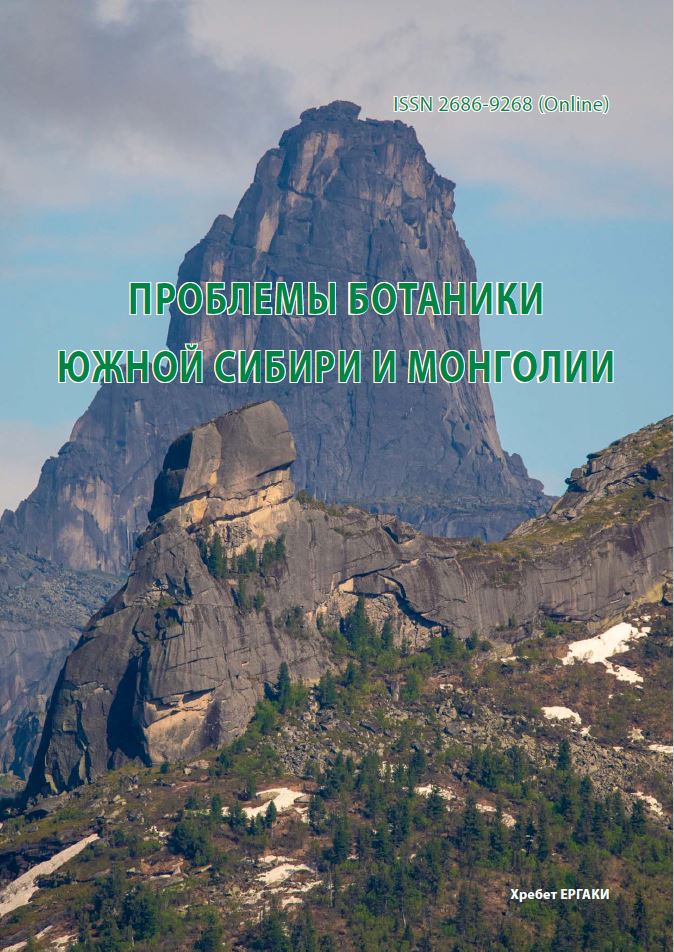The effect of plant size on the phytoliths characteristics of short cells in the leaf epidermis of Dactylis glomerata L.
УДК 582.542.1:581.8+581.55(571.150)
Abstract
The present study is devoted to the revision of the influence of plant organs size on the size of phytoliths. Phytolith size parameters are used to identify cultivated grasses species in archaeological sites. Understanding how these characteristics are variable is necessary in such studies. The study of the variability of the phytoliths morphometric parameters will increase the possibilities of their use in plant systematics. The article presents a correlation analysis between the average values of the morphometric characteristics of Dactylis glomerata phytoliths from six different habitats with leaf sizes and generative shoots. The cock’s-foot specimens from forest, meadow and anthropogenically disturbed plant communities in the mountainous and plain parts of the south of Western Siberia were studied. Extraction of phytoliths was carried out using dry ashing. The measurement was made using the ImageJ software. Past 4.03 programs was used for statistical processing. The influence of the leaf length on the average values of the parameters of width, equivalent diameter, and inscribed radius of phytoliths of short epidermal cells of leaf was revealed. With an increase in the size of the leaf, the width of the phytolith and the parameters associated with it increase. The length of phytoliths, their area, perimeter, area and perimeter of the described figures weakly depend on the size of the vegetative organs of plants.
Key words. Crenate, Dactylis glomerata, morphometry, phytoliths, short cells.
Downloads
Metrics
References
Арепьева Л. А. Синантропные сообщества с Dactylis glomerata L. в Курской области // Растительность России, 2018. - № 33. - С. 3-18.
Веселкова Н. Р. Популяции Dactylis glomerata L. в условиях крупного промышленного города // Экологические проблемы промышленных городов: Сб. науч. тр. 5-й Всерос. науч.-практ. конф. с междунар. участием (г. Саратов, 12-14 апреля 2011 г.). - Саратов: СГТУ им. Ю. А. Гагарина, 2011. - С. 203-206.
Веселкова Н. Р. Популяционно-онтогенетические и биоморфологические исследования Dactylis glomerata L. на территории Удмуртской Республики // Актуальные проблемы современной биоморфологии. - Киров: Савиных Н. П., 2012. - С. 247-254.
Веселкова Н. Р., Красноперова С. А. Био- и морфоэкотипы ежи сборной (Dactylis glomerata L.) в г. Ижевске и его окрестностях // Флора Урала в пределах бывшей Пермской губернии и ее охрана: Материалы Межрегион. конф., посвящ. 140-летию со дня рождения П. В. Сюзева / Под ред. Е. И. Демьяновой, С. А. Овеснова, Л. Г. Пере-веденцевой (г. Пермь, 18-19 декабря 2007 г.). - Пермь: изд-во ПГНИУ, 2007. - С. 46-50.
Горчакова А. Ю., Лиференко О. В. Влияние различных биотопов на формирование побегов у растений ежи сборной (Dactylis glomerata L.) // Экологический вестник Северного Кавказа, 2009. - Т. 5, № 3. - С. 67-71.
Загайнова А. А., Скочилова Е. А., Закамская Е. С. Влияние автотранспорта на продукционный процесс Dactylis glomerata L. // Сборник научных трудов SWORLD, 2013. - Т. 37, вып. 1. - С. 19-21.
Красноперова С. А., Веселкова Н. Р. Эколого-ценотическая и морфологическая характеристика Dactylis glomerata L. в условиях Удмурской Республики // Вестник ЧГПУ 2011. - № 9. - С. 357-365.
Лайдинен Г. Ф., Казнина Н. М., Батова Ю. В., Титов А. Ф. Изменчивость морфологических признаков у растений Dactylis glomerata L. в условиях антропогенного воздействия // Северная Европа в XXI веке: природа, культура, экономика: Матер. междунар. конф., посвящ. 60-летию КарНЦ РАН (г. Петразаводск, 24-27 октября 2006 г.). - Петразаводск: Карельский научный центр РАН, 2006. - С. 135-136.
Fernandez M. G., Zucol A., Arriaga M. O. Comparative phytolith analysis of Festuca (Pooideae: Poaceae) species native to Tierra del Fuego, Argentina // Botany, 2012. - Vol. 90, № 11. - P. 1113-1124. DOI: 10.1139/b2012-070
Hoskova K., Neustupa J., Pokorny P., Pokorna A. Phylogenetic, ecological and intraindividual variability patterns in grass phytolith shape // Annals of Botany, 2022 .- Vol. 129, № 3. - P. 303-314. DOI: 10.1093/aob/mcab143.
Iler R. K. The Chemistry of Silica: Solubility, Polymerization, Colloid and Surface Properties and Biochemistry of Silica. - New York: Wiley-Interscience, 1979. - 896 pp.
Katz O. Silica phytoliths in angiosperms: phylogeny and early evolutionary history // New Phytologist, 2015. - № 208. -P. 642-646. DOI: 10.1111/nph.13559
Madella M., Alexandre A., Ball T. International Code for Phytolith Nomenclature 1.0. // Annals of Botany, 2005. -Vol. 96. - P. 253-260. DOI: 10.1201/NOE9058093455.ch1
Neumann K., Stromberg C., Ball T., Albert R. M., Vrydaghs L., Cummings L. S. International Code for Phytolith Nomenclature (ICPN) 2.0. // Annals of Botany, 2019. - Vol. 124, № 2 - P. 1-11; 1-41. DOI: 10.1093/aob/mcz064
Rudall P. J., Prychid C., Gregory T. Epidermal patterning and silica phytoliths in Grasses: An evolutionary history // The Botanical Review, 2014. - Vol. 80, №1. - P. 59-71. DOI: 10.1007/s12229-014-9133-3



